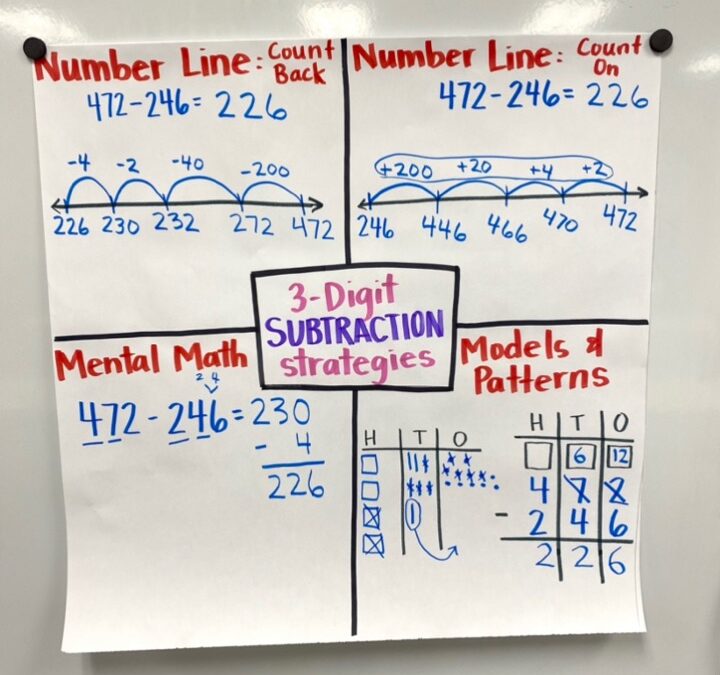A big standard for 2nd grade students is learning different subtraction strategies for 3-digit numbers. My first year teaching 2nd grade, these lessons intimidated me.
“We made it through some hard lessons…” That’s what I heard years ago at lunch from the 2nd grade teachers when I was doing my student teaching. (I student taught in a first grade classroom.) Little did I know that I would be hired as a 2nd grade teacher the next year in that district, and I would be teaching those hard lessons.
Can you guess what lessons they were talking about?
It was 3-digit subtraction strategies.
And my first year teaching, they were hard lessons. For me and the students! I had no clue how to teach them and I felt like the curriculum didn’t give students enough practice with them for them to be successful.
And the practice they did offer, didn’t match the format they had used in the lesson. This drove me crazy because students would be extra confused when doing the practice pages! And it was not helpful for anyone…
So I started making supplemental resources to give my students quality extra practice.
When students got this practice in, things started clicking for them. They were able to choose different strategies to use and actually be accurate with the answers.
Over the years of teaching subtraction strategies, I’ve discovered what students need in order to be successful with these 3-digit subtraction strategies.
Before students are ready for these subtraction strategies for 3 digit numbers, they need a good foundation with math facts and place value concepts. I’ve learned that students do so much better with these strategies for subtraction when you review the place value concepts involved in the strategy and when you help students discover patterns that are needed to do the strategies.
So today, I’m sharing the 4 different 3-digit subtraction strategies I teach in my 2nd grade classroom including the place value concepts that directly correlate with these strategies and the patterns students need to notice for each of these strategies.
But before we get started, it’s important to know that students do much better with 3-digit subtraction strategies when they are fluent with their basic addition and subtraction math facts. I have a free workbook to help you get your students to math fact fluency: The 7 Steps to Ensure Math Fact Fluency. Download your free copy here.
Subtraction Strategies For 3-Digit Numbers
The 3-digit subtraction strategies I teach my students are the open number line strategy counting back, open number line add up to subtract, mental math or the break apart strategy, and regrouping or the standard algorithm.
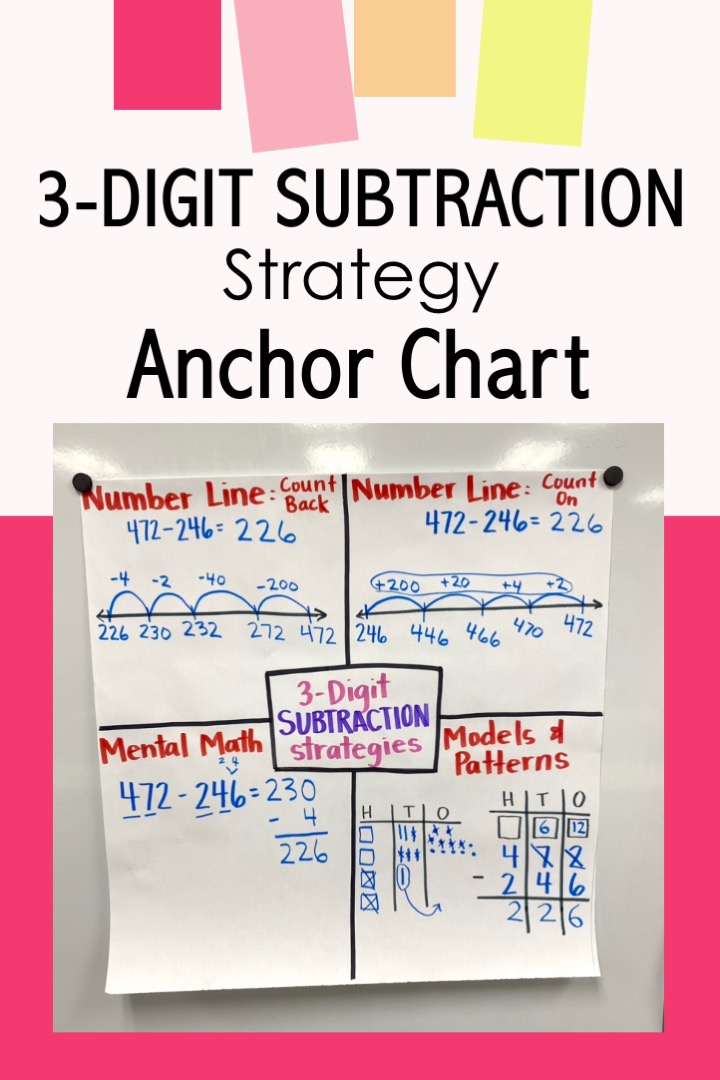
I like to teach my 2nd grade students all of the subtraction strategies for 3-digit numbers. That way they can choose a strategy they like to solve 3-digit subtraction equations. This 3-digit subtraction strategies anchor chart helps them do that.
Open Number Line Strategy – Counting Back
With this subtraction strategy, students make jumps back of hundreds, tens, and ones on an open number line to subtract the two 3-digit numbers. For students to do this they need to know the patterns involved when subtracting 100 and 10 from a 3-digit number.
To help students learn these patterns I like to write up a bunch of equations with 3-digit numbers subtracting 100 and 10 on the board. We solve them as a class and soon students know that when we subtract a 100 from a number, the hundreds number decreases by 1. They also see when we subtract 10, the tens number decreases by 1. They also discover what I call “our special zero pattern.” This is where the 3-digit number you are subtracting from as a zero in the tens place and you are subtracting 10 from it. After solving a few of these, students discover that the hundreds number decreases by 1, the tens number changes to a 9, and the ones number stays the same. Find practice activities to help students learn these patterns here.
Once students learn these, they are ready to solve 3-digit numbers on an open number line.
Let’s look at an example with the equation 835 – 122. For students to solve this equation, they would start by making a little “tick” on the right side of the open number line and label it 835 underneath.
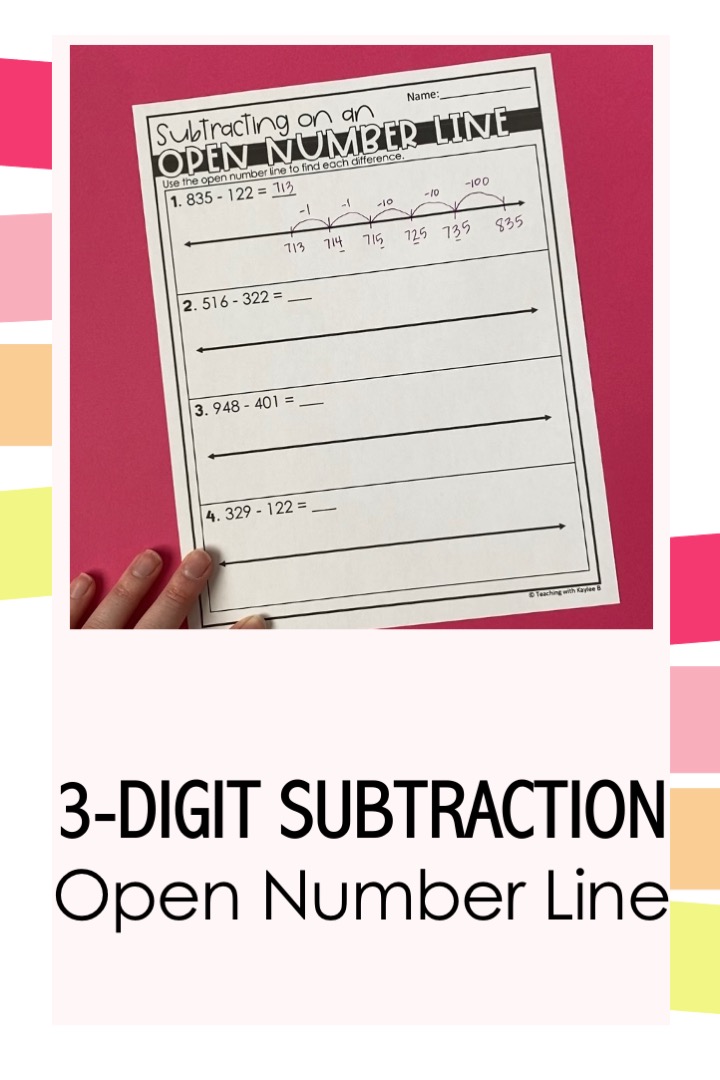
Once students can use mental math to subtract 100, 10, and 1 from a 3-digit number, it makes teaching subtraction strategies so much easier.
Then they look at how many hundreds are in the number they are subtracting. In this case, students make 1 one hundred jump back. They label this jump with “-100” up above the jump. Down below they are going to subtract 100 from their starting number. So they would write “735” underneath.
Then they look at how many tens are in the number they are subtracting and make that many jumps. For this example, they make 2 ten jumps and label them “-10” up above. Then they need to write the numbers underneath where they subtract 10, so they write “725” and “715.”
And finally, they look at how many ones are in the number they are subtracting. There are 2 ones in 122 so students then make two jumps and label them “-1” up above. Down below they write the numbers “714” and 713.” The last number they write underneath is their answer.
Now let’s talk about the place value concepts students need to know before you teach this strategy. Students need to know what the hundreds place is, the tens place is, and the ones place. They need to know that the 1 in 122 doesn’t just mean 1, it means 100. And so on with the tens number and the ones number. I have a blog post where I share exactly how to teach this concept to your students. Read it here: Place Value Standards: How to Best Teach Them to 2nd Grade Students
Find all of my resources to teach the open number line strategy in my money-saving bundle here.
Open Number Line – Add Up to Subtract
Subtraction fascinates me because we can add up to subtract. I teach my students this at the beginning of the school year with basic math facts. If we have an equation like 7-5, we can think how many more is 7 than 5. It’s 2. We can also think of it like 5 plus something equals 7. I like to remind students this before this lesson by using fact families. Learn more about fact families in this blog post here.
We can “think addition to subtract” with larger equations as well. Let me show you with this example: 735 – 524 =
On an open number line, you put the greater number in the equation on the right side and the lesser number on the left side. Then you have students make jumps up hundreds, tens, and ones until they reach the bigger number. To get your answer, you add up the jumps.
When you add up the jumps from 524 to 735 you get 211. So 735-524=211.
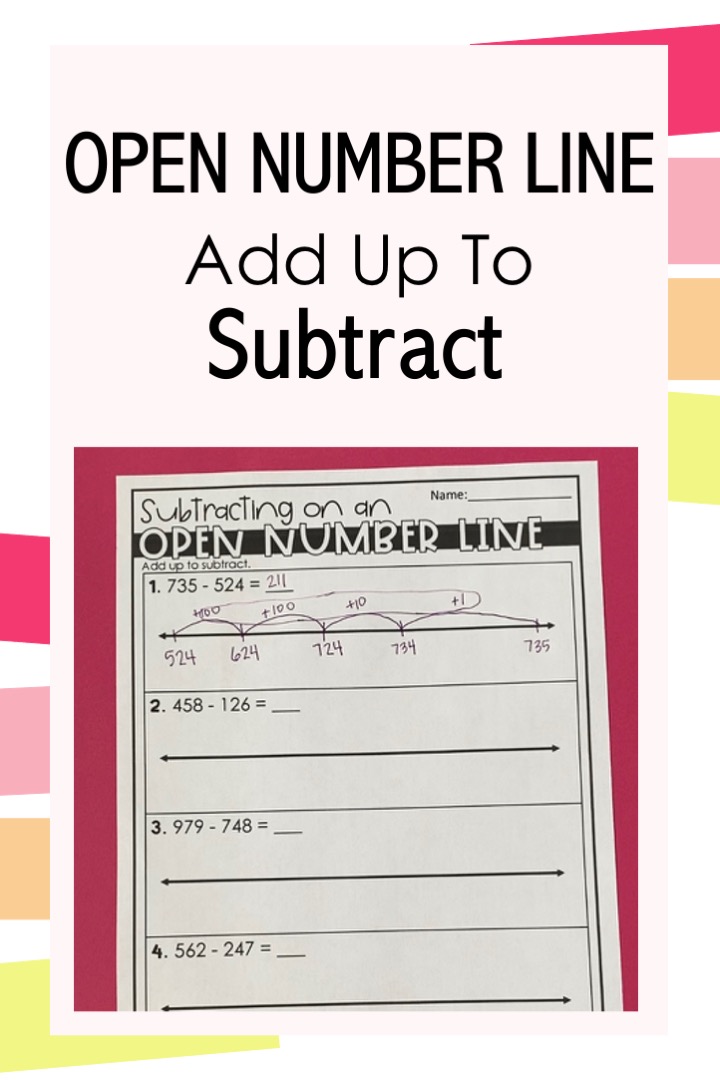
When students struggle with strategies for subtraction, that is when I like to teach them that they can think addition to subtract.
As you can see, students need to know important place-value concepts for this strategy. But luckily they are similar to the ones for the counting back strategy. They need to know what the hundred number means, what the tens number means, and what the ones number means. Read more about teaching place value standards here.
Find all the resources you need to teach with subtraction strategy to your students here in this money-saving bundle: 3-Digit Subtraction Strategies Bundle
Mental Math 3-Digit Subtraction Strategy
For this 3-digit subtraction strategy, subtract the hundreds, the tens, and then the ones. But when there are not enough tens or ones to subtract from, students break apart the numbers to make easier numbers to subtract from.
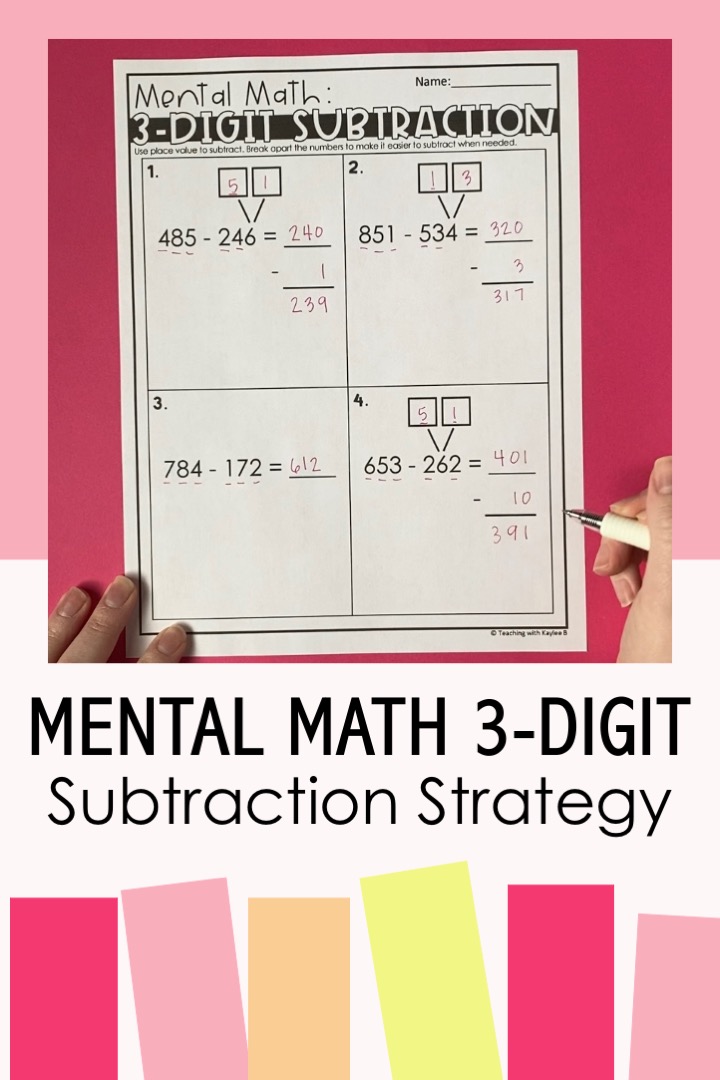
This is one of most important subtraction strategies for 3-digit numbers because it allows students to solve 3-digit subtraction equations at any time.
Let me give you an example with this equation: 485 – 246 =
Start with the hundreds, 4-2=2. Then go to the tens, 8-4=4. After that, go to the ones. But if you have 5 ones, you can’t take away 6. So we break the 6 apart into 5 and 1. Then this gets you the equation 5-5=0. You can put the hundreds, tens, and ones together to get 240. But you still need to subtract one more because you broke the 6 apart into 5 and 1. So your answer is 239.
You can do the same thing when there are not enough tens to subtract. You break apart the tens number to make an easier equation. Just remember that when you are breaking apart the number in the tens place, you are working with tens. So when you go to subtract the extra number, put a zero behind it.
Let me give you an example with this equation: 653 – 262 =
You subtract the hundreds 6-2=4. Then you go to the tens but there are not enough tens, so you break 6 into 5 and 1. So 5-5=0. After that, you subtract the ones, 3-2=1. Then you put your hundreds, tens, and ones together to get 401. But you still need to subtract another 10, so the answer is 391.
For this strategy, students need to know the patterns when subtracting multiple ones from a 3-digit number and multiple tens from a 3-digit number.
They also need to know place value patterns to help understand this. Read more about teaching place value patterns in this blog post here.
Regrouping 3-Digit Subtraction Strategy
For regrouping, I eventually get students while they line up the numbers and start with the ones to subtract. If there are not enough ones, they regroup a ten into 10 ones. Then they move over to subtract the tens. If there are not enough tens, they regroup a hundred into 10 tens. Finally, they subtract the hundreds to get to the answer.
But it takes some time to teach this subtraction strategy so that students build understanding on what it means to regroup instead of just following rote rules. To do this, I first have students solve these equations by drawing base ten blocks. I have them do this in a hundreds, tens, and ones chart. Then circle a ten they are regrouping, draw an arrow to the ones, and then draw in 10 ones. They do a similar thing when they need to regroup into the tens. They circle a hundred, draw over an arrow to the tens, and then draw in 10 tens. This helps students see why regrouping works.
Then the next day we do a lesson where I still have students draw models to solve, but they also line up the numbers to show what they are doing with the pictures.
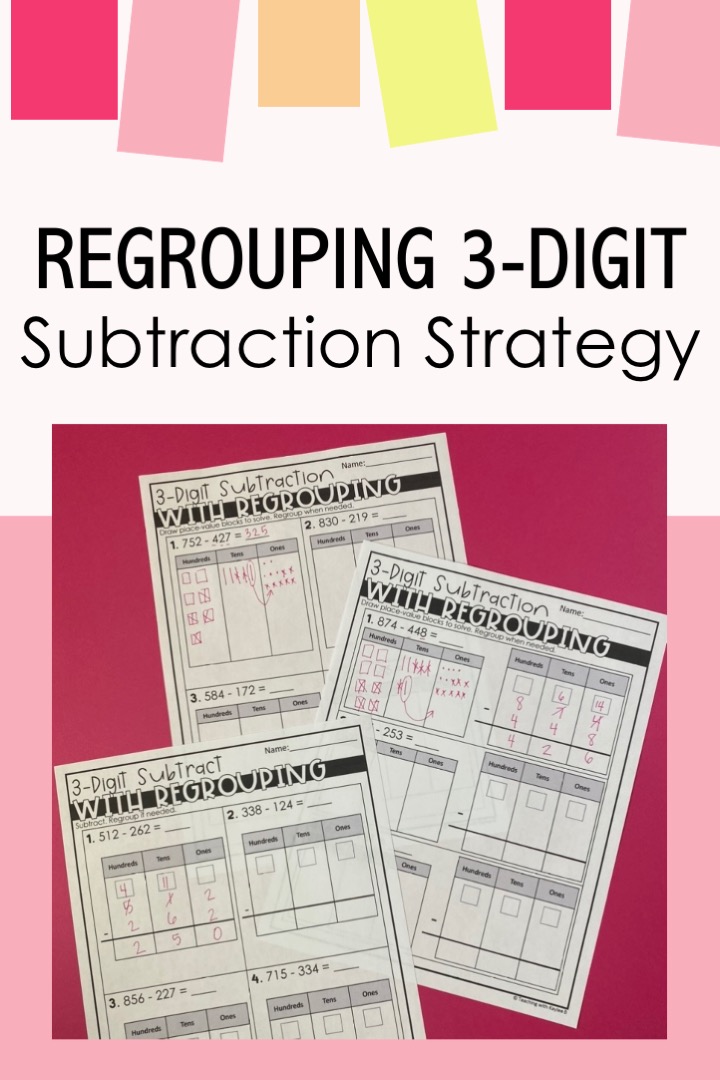
Subtraction strategies for 3-digit numbers are so important that it is okay to take a few days to teach each one.
After that, I have a lesson where I help students see patterns that they can apply with just lining up the numbers to solve.
These patterns include that when students regroup, the place where they regroup from has one less. And the place where they need more has 10 more.
When you teach regrouping lessons in this way, things fall into place for students. They don’t struggle with the steps because they have seen the mechanics of it all. They really do master regrouping for subtraction!
Find all of the resources I use to teach the regrouping method in this money-saving bundle here.
I have a full blog post going into more detail about how to teach 3-digit subtraction with regrouping. Read it here: How to 3-Digit Subtraction With Regrouping: Expert Strategies for Building Understanding
3 Number Subtraction Worksheets
As I am teaching each of these 3-digit subtraction strategies, I like to provide support along the way. I make sure to teach place value lessons before teaching subtraction strategies. Learn about these lessons in this blog post here. I review the place value concept that directly correlates with the subtraction strategy right before I introduce the new strategy. Find the resources I use to do this here.
The worksheets I use to teach these strategies have different features that help guide students. After that, I give students 3 number subtraction worksheets that slowly take away those features so that students can do these different 3-digit subtraction strategies with a little less guidance. With this scaffolding, soon students are successful with the subtraction strategies!

